Lego helicopters
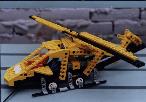 Many
people have been inpired by LEO & LEGO
to work on LEGO-realisations of very complicated mechanical structures such
as as clocks and helicopter rotors. Leo also gives a very nice explanation of
the working of helicopter blades. A very nice demonstration model that can only
control the lift is the propperchopper on CMU's LEGO
stuff This model can demonstrate lifting and landing because it is
mounted on a balance. A complete model of a cobra helicopter with pneumatic
control of both main and rear rotor blades (no cyclic control) has been created
by Andrew
Bisell and Steve Robinson .
Many
people have been inpired by LEO & LEGO
to work on LEGO-realisations of very complicated mechanical structures such
as as clocks and helicopter rotors. Leo also gives a very nice explanation of
the working of helicopter blades. A very nice demonstration model that can only
control the lift is the propperchopper on CMU's LEGO
stuff This model can demonstrate lifting and landing because it is
mounted on a balance. A complete model of a cobra helicopter with pneumatic
control of both main and rear rotor blades (no cyclic control) has been created
by Andrew
Bisell and Steve Robinson .
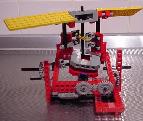 First
trial spring 2002. My son, Joep (now 14 years old) and I tried to
find a new construction for the rotor. The result is still not good enough to
be used a directable fan as Leo suggested for his design.
First
trial spring 2002. My son, Joep (now 14 years old) and I tried to
find a new construction for the rotor. The result is still not good enough to
be used a directable fan as Leo suggested for his design.
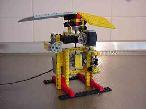 Second
trial summer 2002. Because our final goal is a full demonstration
of cyclic control and lift control we tried to improve the results from the
first trial. The result is a rotor design that can be driven by a motor. The
Lift and two cyclic controls are realized using worm gears . This model could
be used as a directionable fan. However, the rotation speed is not very high.
Second
trial summer 2002. Because our final goal is a full demonstration
of cyclic control and lift control we tried to improve the results from the
first trial. The result is a rotor design that can be driven by a motor. The
Lift and two cyclic controls are realized using worm gears . This model could
be used as a directionable fan. However, the rotation speed is not very high.
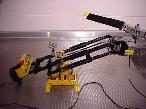 Third
trial autumn 2002. After some experiments , we decided to be
less ambitious and to build a new approach for the propperchopper. We think
that the idea of demonstrating the working of a helicopter with a balance can
be extended to other movements of a helicopter as well. So comments and suggestions
are welcome! We are currently doing experiments with an improved control for
the last design and designing a new balance to demontrate lift, landing and
cyclic control.
Third
trial autumn 2002. After some experiments , we decided to be
less ambitious and to build a new approach for the propperchopper. We think
that the idea of demonstrating the working of a helicopter with a balance can
be extended to other movements of a helicopter as well. So comments and suggestions
are welcome! We are currently doing experiments with an improved control for
the last design and designing a new balance to demontrate lift, landing and
cyclic control.
This month, september 2002, I discovered a very beautifull model
by Ross
Crawford that shows all the controls! Why haven't I seen his model earlier
? .
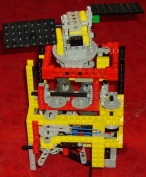 Fouth
trial winter 2008. After 6 years not thinking of helicopters,
I decided to work on a cyclic control based on the use of differentials. The
inspiration for this device came from my experiments with reverse bar mechanisms
in simulated steam engines that are powerd by vacuum cleaners.
Fouth
trial winter 2008. After 6 years not thinking of helicopters,
I decided to work on a cyclic control based on the use of differentials. The
inspiration for this device came from my experiments with reverse bar mechanisms
in simulated steam engines that are powerd by vacuum cleaners.
HOME
 Many
people have been inpired by LEO & LEGO
to work on LEGO-realisations of very complicated mechanical structures such
as as clocks and helicopter rotors. Leo also gives a very nice explanation of
the working of helicopter blades. A very nice demonstration model that can only
control the lift is the propperchopper on CMU's LEGO
stuff This model can demonstrate lifting and landing because it is
mounted on a balance. A complete model of a cobra helicopter with pneumatic
control of both main and rear rotor blades (no cyclic control) has been created
by Andrew
Bisell and Steve Robinson .
Many
people have been inpired by LEO & LEGO
to work on LEGO-realisations of very complicated mechanical structures such
as as clocks and helicopter rotors. Leo also gives a very nice explanation of
the working of helicopter blades. A very nice demonstration model that can only
control the lift is the propperchopper on CMU's LEGO
stuff This model can demonstrate lifting and landing because it is
mounted on a balance. A complete model of a cobra helicopter with pneumatic
control of both main and rear rotor blades (no cyclic control) has been created
by Andrew
Bisell and Steve Robinson . 


